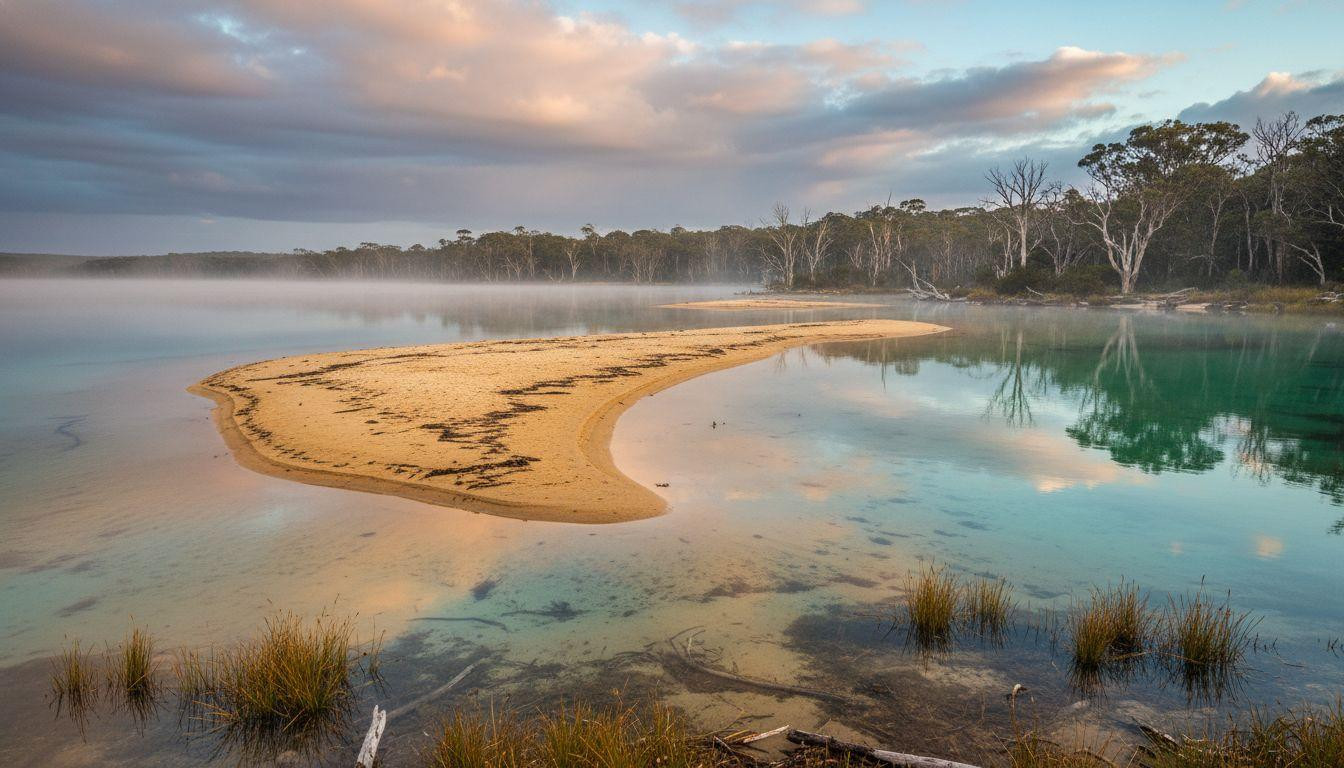Dawn breaks at 6:47 AM as your kayak glides across Myall Lake’s glassy surface. Turquoise water mirrors the sky while a sea eagle calls from a distant Melaleuca tree. This is Australia’s largest coastal lake system, 44,000 hectares of Ramsar-protected wilderness just 155 miles north of Sydney. Yet only 50,000 visitors discover it annually compared to Sydney Harbour’s millions. No crowds, no noise. Just endless brackish waterways where golden sandbanks emerge from emerald shallows and camping beaches rest untouched beneath coastal bush.
Where brackish wilderness meets the Mid North Coast
Myall Lakes stretches across the Mid North Coast between Tea Gardens, Hawks Nest, and Bulahdelah. The protected lake system encompasses Bombah Broadwater, Myall Lake, and Violet Hill Passage. These interconnected waterways blend saltwater lagoons with freshwater inflows.
Established as national park in 1972 and designated Ramsar Wetland in 1999, this 44,000-hectare sanctuary guards ancient ecosystems unchanged for millennia. Most travelers rush past on the Pacific Highway toward Byron Bay, never noticing the turnoff for The Lakes Way. Those who do find empty boat ramps at Nerong, Korsmans Landing, and Mungo Brush where putting-in means paddling into solitude.
The Ramsar wetland most kayakers never see
Crystal waters between golden sands
The Broadwater stretches 5 miles across, shallow enough to see bottom clearly yet deep enough to paddle freely. Turquoise fades to emerald where channels deepen. At 2 Mile Sands, golden beaches emerge from the water like desert mirages.
Violet Hill Passage winds between coastal vegetation where morning light catches Melaleuca bark in silver-white contrasts. This lake where morning mist rises from 705 feet of glacial water offers similar pristine kayaking, but lacks Myall’s coastal accessibility.
Wildlife that outnumbers visitors
Sea eagles and whistling kites patrol overhead. Eastern grey kangaroos emerge at dawn along shorelines. Goannas sun themselves on driftwood while the occasional dingo watches from coastal ridges.
This isn’t manufactured eco-tourism. It’s a functioning wetland ecosystem where 50,000 annual human visitors remain statistical noise against millions of bird migrations, fish breeding cycles, and ancient water patterns.
Paddling through 44,000 protected hectares
Multi-day kayak camping
Launch from Korsmans Landing for overnight expeditions to 2 Mile Sands or remote Broadwater beaches. Pack camping gear in waterproof hatches. Paddle 9-12 mile days through glass-calm morning conditions before afternoon easterlies arrive.
Beach your kayak on empty sand. Watch sunset paint the water rose-gold. Wake to sea eagle calls and mist rising from the lake. National Park camping permits cost $8 per vehicle per night at Mungo Brush or Bombah Point.
Day paddles and fishing culture
Shorter routes from Nerong explore Bombah Point and nearby inlets in 5-7 mile loops. The lakes support recreational fishing for bream, flathead, and tailor, though catch-and-release prevails in protected zones.
Kayak rentals from local outfitters run $40-80 per day, with guided paddles costing $80-120 for those wanting expert route knowledge through this maze of channels. This beach where 94 miles of golden sand curve beyond sight along Bass Strait provides similar coastal wilderness within driving distance from major cities.
The anti-Sydney experience at scale
While 5 million tourists annually flood Sydney Harbour’s 21 square miles, Myall Lakes’ 173 square miles host 50,000 visitors. The mathematics of solitude become tangible here. Paddle 30 minutes from any launch point and see no one.
The scale feels infinite with horizon-to-horizon water, endless coastline, and channels disappearing into coastal bush. Yet civilization remains close. Tea Gardens offers groceries, cafes, and fuel just 15 minutes from launch points. This beach where wild kangaroos rest on white sand between turquoise waves showcases similar Australian coastal wilderness where authentic wildlife encounters happen naturally.
This proximity-without-crowds paradox defines Myall Lakes’ appeal for kayakers seeking authentic wilderness access.
Your Questions About Myall Lakes kayaking answered
When should I visit for best kayaking conditions?
Spring (September-November) delivers warm weather at 68-77°F, manageable afternoon breezes, and fewer crowds than summer holidays. November 2025 sits in the sweet spot with post-winter rains filling the lakes while pre-Christmas crowds stay away. Summer brings warmest temperatures but peak-season traffic and stronger easterlies that roughen afternoon water.
What does a weekend at Myall Lakes cost?
Camping at Mungo Brush costs $8 per vehicle per 24-hour period through NSW National Parks booking. Kayak rentals run $40-80 daily. Guided tours cost $80-120 per person. Tea Gardens accommodation ranges $80-250 nightly. Compare this to $200-400 Sydney hotel rates plus harbor kayak tours at $100-150. This tiny island turns gold when evening light catches coral sand beaches offers similar remote-but-accessible positioning for Australian island destinations.
How does this compare to other Australian coastal kayaking?
Myall Lakes offers scale and solitude impossible in Sydney Harbour, better accessibility than Tasmania’s remote coastal wilderness, warmer conditions than Victoria’s Gippsland Lakes, and authentic wilderness lacking in Queensland’s commercialized Whitsundays. The brackish water conditions and protected wetland status create unique paddling environments unavailable elsewhere on the Australian coast.
Your paddle dips silently into turquoise water at dawn while a sea eagle circles overhead. Golden light catches Melaleuca reflections as 2 Mile Sands glows amber in the distance. This is Myall Lakes, 173 square miles of Ramsar wilderness where morning mist rises and kayakers disappear into protected solitude just three hours from Sydney’s millions.
